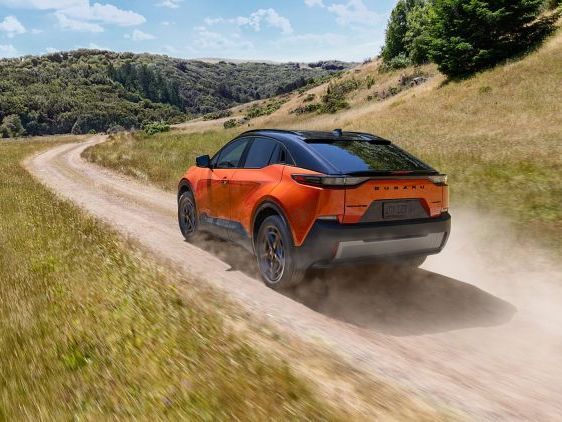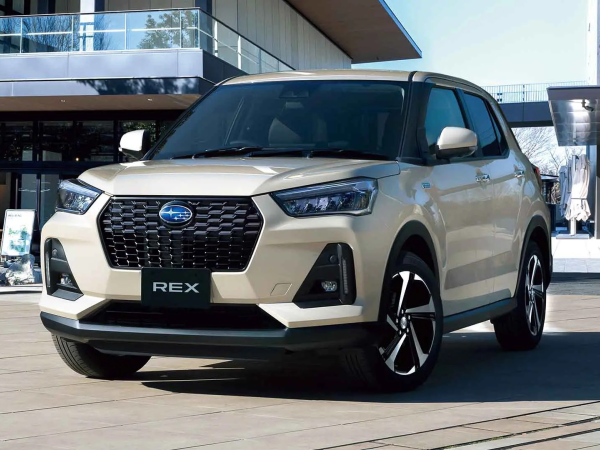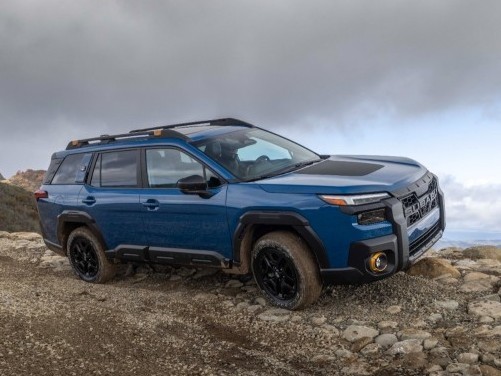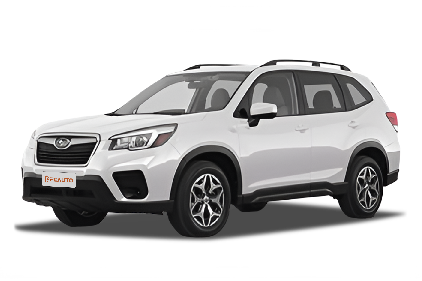Q
What kind of engine is in the 2019 Subaru Forester?
The 2019 Subaru Forester in the Malaysian market comes with a 2.0-liter horizontally opposed four-cylinder naturally aspirated engine (FB20 type), delivering 156 horsepower and 196 Nm of peak torque. It's paired with a Lineartronic continuously variable transmission (CVT) and the Symmetrical All-Wheel Drive system. This engine features direct injection technology, optimizing fuel efficiency and low-end torque performance—perfect for Malaysia's mix of urban and suburban roads. The boxer engine's low center of gravity enhances cornering stability, while the full-time AWD system handles slippery wet roads during the monsoon season. Notably, Subaru's engine layout stands out from most brands; its horizontally opposed configuration effectively reduces vibration, though owners should keep up with regular maintenance to ensure long-term reliability. If you're craving more power, check out the brand's turbocharged models, but the naturally aspirated version is easier on maintenance costs and fuel compatibility—better suited for Malaysia's daily driving conditions.
Special Disclaimer: This content is published by users and does not represent the views or position of PCauto.
Related Q&A
Q
What is the difference between 2018 and 2019 Forester?
The main difference between the 2018 and 2019 Subaru Foresters lies in the fact that the 2019 model received a full fifth-generation redesign. The exterior got a more modern look, with slightly increased overall dimensions and a 30mm longer wheelbase that improves rear passenger space. The 2019 Forester switched to the new Subaru Global Platform (SGP), which significantly boosted body rigidity and optimized the suspension system, leading to noticeable improvements in driving stability and cabin noise insulation.
Under the hood, the 2019 model in the Malaysian market primarily features a 2.0-liter direct-injection naturally aspirated engine paired with a Lineartronic CVT transmission. While horsepower remains similar to the 2018 version, fuel efficiency sees an uptick. Inside, the 2019 Forester gets an all-new interior design, with a larger standard infotainment screen and, for the first time, the inclusion of Subaru's EyeSight driver assistance system (on select trim levels), which bundles adaptive cruise control and pre-collision braking.
Notably, the 2019 model dropped the previous turbocharged variant but enhanced the functionality of the X-Mode off-road system. For Malaysian consumers, the 2019 Forester better meets the latest ASEAN NCAP safety standards. It also retains a 220mm ground clearance, making it well-suited to local road conditions. If considering a used car purchase, the 2019 model's updated platform offers potential long-term durability benefits. Meanwhile, some 2018 models might present more attractive pricing due to the lack of the EyeSight system.
Q
How big is the gas tank on a 2019 Forester?
The 2019 Subaru Forester has a fuel tank capacity of 16.6 gallons (approximately 63 liters), a design that delivers an extended driving range, perfect for both long highway trips and daily city commutes in Malaysia. As a compact SUV, the Forester's tank size strikes a nice balance between fuel efficiency and practicality. Paired with its 2.5-liter boxer engine and Symmetrical AWD system, it handles a variety of road conditions – from Malaysia's frequent rainy season wet roads to rough suburban terrains. For owners who love road trips or often drive between states, that larger tank means fewer stops at the pump and more convenience. Keep in mind, though, actual range can vary based on driving habits, road conditions, and vehicle load. Regular maintenance is a good idea to keep fuel efficiency in check. Also, the Forester's fuel tank is made of resin, which is lightweight and corrosion-resistant – a common feature in Subaru models.
Q
What is the oil temperature in Forester 2019?
The oil temperature of the 2019 Subaru Forester typically stays between 90°C and 110°C under normal driving conditions. It might briefly rise to around 120°C during spirited driving or in high-temperature environments, but the boxer engine and efficient cooling system do a solid job of keeping it in check. For Malaysian owners, the tropical climate could push the oil temperature a bit higher. I'd recommend regularly checking the oil condition and using fully synthetic oil that meets the factory specs to ensure optimal lubrication and heat dissipation. Oil temperature is a key indicator of engine health—too high can cause lubrication failure, while too low hurts fuel economy. The Forester's oil temperature gauge or warning light helps keep an eye on any issues. During routine maintenance, besides oil temperature, keep an eye on coolant levels and radiator cleanliness since these also affect oil temperature indirectly. If you notice the oil temperature spiking abnormally often, head to an authorized service center for a professional check to avoid potential long-term engine damage from prolonged high temperatures.
Q
How many litres are in a 2019 Subaru Forester?
The 2019 Subaru Forester has a 55-liter fuel tank, which is above average for its SUV class. That's a solid size for both long highway drives and city commutes here in Malaysia. True to Subaru's focus on practicality and safety, the tank design also ties into the Forester's fuel efficiency. Pairing the 2.0-liter boxer engine with the Lineartronic CVT delivers a smooth ride and pretty decent gas mileage. For Malaysian drivers, 55 liters means fewer stops at the pump since you can cover more ground on a full tank. Plus, Subaru's Symmetrical All-Wheel Drive system is a real plus during Malaysia's rainy seasons, giving better grip and stability on wet roads. And hey, keeping up with regular maintenance and driving smart can definitely help stretch that fuel even further. It's always a good idea to stick to the official service schedule to keep your Forester running at its best.
Q
How to check oil level 2019 Subaru Forester?
To check the oil level in a 2019 Subaru Forester, first make sure the vehicle is parked on level ground and the engine is turned off. Wait 5-10 minutes to let the oil drain back into the oil pan, then pop the hood and locate the dipstick—it’s usually got a yellow or orange pull tab. Pull it out, wipe it clean with a rag, stick it back in all the way, then pull it out again. Check where the oil mark lands—it should be between the "MIN" and "MAX" lines. If it’s below "MIN", top it off with the oil specified in the owner’s manual. If it’s at or above "MAX", you’ll need to drain some out to prevent engine damage. With Malaysia’s hot climate, it’s a good idea to check the oil condition regularly too. If it looks black or has metal particles, you might need an early oil change. Also, the Forester’s boxer engine tends to burn a bit more oil than inline engines, so owners should get in the habit of checking it monthly to keep the engine well-lubricated and extend its life.
Q
How much oil does a 2019 Subaru Forester take?
The 2019 Subaru Forester has an oil capacity of approximately 5.4 liters, including the oil filter. If you're just changing the oil without replacing the filter, you'll need around 5.0 liters. The exact amount might vary slightly depending on the engine model or region, so it's best to check your vehicle's owner's manual or consult an authorized Subaru Malaysia dealer for precise info. In Malaysia's hot and humid climate, picking the right oil viscosity is super important. The Forester typically recommends 0W-20 or 5W-30 full synthetic oil – these types hold up well under high temperatures, maintaining good lubrication while also helping boost fuel efficiency. Regular oil and filter changes are key to keeping your engine healthy; it's generally advised to do this every 10,000 kilometers or 6 months, whichever comes first. Plus, Subaru's Boxer engine has that unique horizontally opposed design, which means it's a bit pickier about oil. So make sure you use oil that meets Subaru's certification standards to keep the engine running smoothly for the long haul. If you're not sure how to choose the right oil or handle the maintenance, head over to Subaru Malaysia's official service centers. Their professional technicians will hook you up with solid advice and service.
Q
How big is the fuel tank on a 2019 Subaru Forester?
The 2019 Subaru Forester has a 55-liter fuel tank capacity. This design balances daily commuting and long-distance travel needs while delivering solid range performance. For Malaysian users, a 55-liter tank is above average for the SUV class, handling most driving scenarios—like the KL to Penang highway run without constant refueling stops. As a practical, safety-focused SUV, the Forester's tank design also factors in fuel economy. Paired with its 2.0-liter boxer engine and CVT transmission, it delivers well-rounded fuel efficiency. Malaysia's varied road conditions, from city traffic jams to rural mountain roads, are no match for the Forester's tank size and fuel efficiency, ensuring consistent driving experiences. If you frequently take long trips, make sure to regularly check the fuel tank and system for optimal performance and safety. Also, keep an eye on Subaru's recommended fuel additives to keep the engine clean and running efficiently.
Q
Is 2019 Forester direct injection?
The 2019 Subaru Forester does come with Direct Injection technology. It's powered by Subaru's FB20 2.0-liter horizontally opposed four-cylinder engine, which combines direct fuel injection with Subaru's unique DOHC (Double Overhead Camshaft) design. This setup boosts fuel efficiency and power output while cutting emissions, making it perfect for both city driving and long trips around Malaysia. The perks of direct injection lie in finer fuel atomization and more precise control over fuel delivery, which ramps up combustion efficiency. But here's the thing—over time, carbon buildup might form on the intake valves, so regular engine maintenance is a good idea to keep it running at its best. Subaru's Symmetrical All-Wheel Drive system is another big win for the Forester. Paired with X-Mode off-road mode, it handles Malaysia's diverse road conditions with ease, whether it's slippery wet roads during the monsoon or rough terrain in the countryside. On top of that, the Forester is equipped with the EyeSight driver assist system, offering features like pre-collision braking and adaptive cruise control to up the safety ante even more. For Malaysian buyers, the 2019 Forester strikes a solid balance between technology, performance, and practicality, making it a SUV well worth considering.
Q
What is the maintenance schedule for a 2019 Forester?
The 2019 Subaru Forester's maintenance schedule recommends regular servicing every 6 months or 10,000 kilometers, whichever comes first. This primarily involves an oil and oil filter change, along with inspections of the brake system, tires, suspension, and undercarriage. You'll also need to replace the air filter every 30,000 kilometers and the spark plugs every 60,000 kilometers. For the transmission fluid and differential oil, it's advisable to check or replace them every 40,000 kilometers to maintain optimal four-wheel-drive performance.
Given Malaysia's climate, pay extra attention to cleaning the cabin air filter – replace it every 15,000 kilometers. The hot and humid conditions can easily lead to mold growth, which affects in-car air quality. Additionally, if you mostly do short city drives, consider shortening the oil change interval to 5,000 kilometers since frequent stop-starts accelerate oil degradation.
The Forester's EyeSight driver assistance system also requires regular calibration, especially after replacing the windshield or being involved in a collision. It's best to have this done at an authorized service center. Note that maintenance intervals may need adjustment based on actual driving conditions. For example, if you frequently drive on gravel roads or coastal areas, you should inspect the brakes and check for undercarriage rust earlier than scheduled.
Q
What is the safety rating of the 2019 Subaru Forester?
The 2019 Subaru Forester excels in safety performance, earning high marks from several authoritative organizations. The Insurance Institute for Highway Safety (IIHS) awarded it the highest rating of "Top Safety Pick+," thanks largely to its robust body structure, standard EyeSight driver assistance system across all trims, and a suite of active safety technologies like automatic emergency braking, lane keep assist, and adaptive cruise control. These features provide added safety even on Malaysia's variable road conditions. For Malaysian consumers, the Forester also boasts an excellent Symmetrical All-Wheel Drive system, which enhances handling stability during rainy weather or on rough terrain, while its generous ground clearance suits some of the country's unpaved roads. It's worth noting that while safety ratings are important, actual driving safety also depends on regular maintenance, tire condition, and driving habits. We recommend owners prioritize tires with strong wet grip, considering local climate characteristics like heavy rainfall, and regularly check the brake system to fully unleash the Forester's safety potential.
Popular Cars
Model Year
Car Compare
Car Photo
Latest Q&A
Q
Is the 2022 Golf R a good daily driver?
The 2022 Golf R makes for a brilliant daily driver. Packing a punch with its 2.0-liter turbocharged engine pumping out 320 horsepower, it delivers power smoothly and responsively through a 7-speed dual-clutch transmission—perfect for both city commutes and highway runs. The suspension strikes a sweet spot between comfort and sportiness, soaking up bumps without breaking a sweat.
Inside, you’ll find a well-crafted cabin with a digital cockpit and plenty of tech, including adaptive cruise and lane-keeping assist, which add real-world convenience and safety. Despite its compact footprint, the interior is smartly packaged, offering decent headroom and legroom front and rear. The trunk’s also practical enough for grocery runs or weekend getaways.
Fuel economy sits around 8-9L/100km combined—reasonable for this performance tier. Maintenance isn’t a headache either, thanks to solid parts availability and a widespread service network.
If you want driving thrills without sacrificing everyday usability, the Golf R nails the balance. Sure, there are other hot hatches in the segment (some Japanese and European rivals come to mind), but the R stands out for its all-around competence.
Q
How much horsepower does the 2022 Golf R have?
The 2022 Golf R packs a 2.0-liter turbocharged four-cylinder engine that delivers 315 horsepower and 420 Nm of torque. Paired with a 7-speed dual-clutch transmission and 4MOTION all-wheel drive, it rockets from 0-100 km/h in just 4.7 seconds – seriously quick for a hot hatch.
What sets the Golf R apart isn’t just raw power. It comes with adaptive chassis control and multiple drive modes, tweaking the suspension and power delivery to suit different roads. Whether you’re commuting or carving corners, it strikes a great balance between daily comfort and sporty handling.
As one of the top performers in the hot hatch segment, the Golf R nails the mix of practicality and driver engagement. If you’re cross-shopping, rivals like the 306-hp Mercedes-AMG A 35 or the 296-hp Audi S3 are worth a look, but the Golf R holds its own with strong overall performance and value.
Q
How much is the 2022 Golf R?
The 2022 Golf R carries an official price tag of approximately RM300,000 to RM350,000 in the local market, though final figures may vary depending on optional extras, dealer incentives, or regional factors. This hot hatch packs a 2.0L turbocharged four-cylinder pushing 315 horsepower and 420Nm of torque, paired with a 7-speed DSG and 4Motion all-wheel drive – good for a 4.7s sprint to 100km/h.
Over the standard Golf, the R variant gets serious upgrades: sport-tuned suspension, high-performance brakes, and aggressive exterior styling. Inside, you'll find Nappa leather sport seats and the latest digital cockpit. While it competes with rivals like the Honda Civic Type R and Mercedes-AMG A45, the Golf R strikes a better balance between daily usability and track-ready performance.
Word to the wise: budget extra for insurance and maintenance packages, and stick with 98-octane fuel for optimal performance. If you're eyeing the used market, expect one-year-old examples to go for about 15% below new-car pricing – just be sure to check for aftermarket mods and warranty status before signing.
Q
What is the top speed of a 2020 Z4?
The top speed of the 2020 BMW Z4 varies by model. The sDrive20i, powered by a 2.0-liter turbocharged four-cylinder, tops out at 240 km/h, while the high-performance M40i variant—with its 3.0-liter inline-six turbo—hits the electronic limiter at 250 km/h. As a driver-focused roadster, the Z4 delivers solid high-speed stability thanks to its tuned powertrain and lightweight construction. The rear-wheel-drive setup and sharp steering also make it seriously nimble.
Word to the wise: If you’re driving one of these in hot, humid conditions, keep a close eye on tire health and stick to the maintenance schedule—heat and moisture can push cooling systems and rubber components to their limits. Some owners opt for aftermarket tuning to bypass the speed limiter, but that’s a gamble with warranty and insurance implications.
Q
How much is a 2020 BMW Z4 worth now?
Based on current used car market trends, a 2020 BMW Z4 is valued between RM250k to RM350k depending on factors like condition, mileage, trim level, and service history. The entry-level sDrive20i tends to be more affordable, while the high-spec M40i variant holds its value better thanks to its 3.0L turbocharged straight-six engine and sportier tuning.
This soft-top roadster offers agile handling and a tech-forward cabin - its iDrive system and wireless Apple CarPlay still feel competitive today. Options like the M Sport package or advanced driver aids can further boost resale value.
Worth noting: The Z4 shares its platform with the Toyota Supra but targets a more luxury-oriented buyer. Niche sports cars like this typically depreciate faster than mainstream models. Before buying, always check the vehicle's maintenance records through authorized used car programs and thoroughly inspect the convertible mechanism. For price reference, it's wise to compare with rival models like the Porsche 718 Boxster or Mercedes SLC from the same year.
View MoreRelated News

Does STI still have a future? Subaru gives the most ambiguous answer with two concept cars
Kevin WongDec 15, 2025

Subaru Registers New EV Trademark, Signaling Strategic Shift
Kevin WongAug 8, 2025

Uncharted is Subaru's first front-wheel-drive car, with a range of up to 482 kilometers.
MichaelJul 18, 2025

SUBARU REX Hybrid vs Nissan e-POWER: Spot the Difference!
WilliamJun 24, 2025

All-New Subaru Outback Debuts with SUV-Inspired Styling
JohnApr 22, 2025
View More


















Pros
Cons